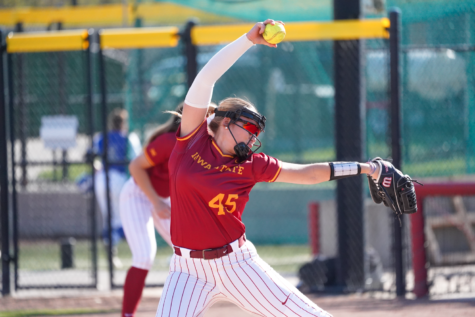Heisman campaigns vary in investments
October 17, 2002
It may not be a 100-foot tall billboard in New York City, but Iowa State is working hard to promote ISU quarterback Seneca Wallace as a contender for the Heisman Memorial Trophy, which is given annually to the top college football player.
Tom Kroeschell, associate athletic director for media relations, said the work on promoting Wallace as a Heisman hopeful began last year.
“We started working last spring on compiling a list of possible voters,” Kroeschell said. “Then at the beginning of this year, we sent out fliers to over 2,000 of them.”
The fliers featured images of Wallace’s face on the Sphinx and banners of him adorning the Leaning Tower of Pisa and the Eiffel Tower.
Kroeschell estimates the campaign will cost $10,000, which is funded by the ISU Athletic Department.
Iowa State’s campaign may seem weak in comparison to last year’s quarter-million dollar promotion of Oregon Ducks quarterback Joey Harrington that featured him on a 100-foot tall billboard hanging in Times Square, but Kroeschell feels Wallace can prove why he deserves the award on the field.
“We did the fliers just to get Seneca’s name out,” Kroeschell said. “Then when they hear of him, they will say, ‘Oh, was n’t that the pyramid guy?'”
Kroeschell said recognizing Wallace should not be a problem anymore.
“Papers are picking him up all over the country,” he said. “At this point, everybody knows him.”
The next step was sending out two highlight tapes updated with Wallace’s more impressive plays.
“We’re using a ‘Seeing is Believing’ theme — when you see what he does, you’ll know how good he is,” Kroeschell said.
According to the Web site developed to promote Wallace, www.gosenecago.com, Wallace is currently leading the Heisman race in ESPN.com’s online poll and is also favored by Ivan Maisel of Sports Illustrated and some Internet sports analysts.
Kroeschell attributes a lot of the success thus far to the exposure ISU football has had on television this year.
“You can’t duplicate the power of television,” he said.
Kroeschell said television coverage was a factor when Troy Davis was a Heisman contender in 1995 and 1996.
“When Troy Davis was fifth in 1995 and second in 1996, they handed out a chart that showed who won by states,” he said. “We carried every part of the country except the East Coast. Why? Danny Wuerffel of Florida was always on TV there. Iowa State was never on TV.”
Other universities rely on the power of media as well.
Doug Walker, sports information director for the University of Miami, said they “aren’t doing a lot out of the ordinary” to promote their two candidates, quarterback Ken Dorsey and running back Willis McGahee.
Walker said they had worked up a flier for Dorsey and were considering one for McGahee.
“We let the performance and team success take care of itself,” he said. He predicted Miami spent “not even $1,000” on the campaign. “We don’t have the money for a large campaign, and we don’t see the need for a large campaign,” he said.
But will that be enough to sway the voters?
It could be.
Consider last year’s race that pitted Harrington against Nebraska quarterback Eric Crouch. Crouch took home the trophy while Oregon’s $250,000 billboard campaign fell short.
Chris Anderson, sports information director for the University of Nebraska, said they did it all by “not spending any money other than postage.” Anderson said they ran color fliers for a couple of mailings about Crouch, printed in-house at no charge.
“We were fortunate last year — like Iowa State is this year — to be on national television often as opposed to regional television. That airtime you just can’t buy,” Anderson said.
















